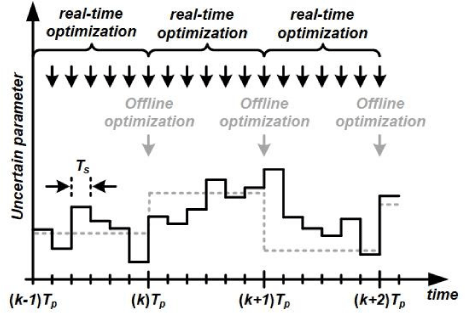Trends in Computer Science and Information Technology
Real-Time Dynamic Optimal Power Flow in Electric Vehicles Considering the Lifetime of the Components in the E-Powertrain
Erfan Mohagheghi1*, Joan Gubianes Gasso1 and Pu Li2
2Department of Process Optimization, Ilmenau University of Technology, Ilmenau, Germany
Cite this as
Mohagheghi E, Gasso JG, Li P (2020) Real-Time Dynamic Optimal Power Flow in Electric Vehicles Considering the Lifetime of the Components in the E-Powertrain. Trends Comput Sci Inf Technol 5(1): 046-047. DOI: 10.17352/tcsit.000020Different types of energy sources (e.g., batteries, supercapacitors, fuel cells) can be utilized in electric vehicles to store and provide energy in the e-powertrain through power electronic devices [1-6]. The lifetime of the components in the e-powertrain depends on their load profile [7,8]. For instance, the lifetime of a battery highly depends on the depth of discharge and the number of charge/discharge cycles [9-13]. The lifetime of an inverter mostly depends on the variations in the active-reactive power passing through it. This means that the expended life cost of the components can be decreased by allocating an optimal share of the total power to each energy source and power electronic device at an optimal time instance. In addition, the driving range of a vehicle can be prolonged by decreasing the energy loss i.e., operating the components in their high-efficiency region. Therefore, it is necessary to perform Optimal Power Flow (OPF) in the operation of the e-powertrain. The OPF aims to minimize the expended life cost of the components and maximize the driving range of the vehicle by optimizing the following decision variables while satisfying technical constraints:
• The charge/discharge power of battery storage and supercapacitor systems ‘at each time instance’
• The charge power of fuel cell systems at each time instance
• The load share of each DC/DC converter
• The bidirectional active and reactive power profiles of each DC/AC inverter
• The length of charge and discharge periods of batteries and supercapacitors
• The number of charge-discharge cycles of each storage unit in each prediction horizon
• The status of charge/discharge of batteries and supercapacitors
• The depth of discharge for storage systems at each time instance
This leads to a large-scale (with hundreds of variables), non-convex, stochastic (due to uncertain parameters), dynamic (due to storage components), multi-timescale, and mixed-integer nonlinear programming (MINLP) problem. Thus, the computation time to solve the problem can be much higher than required for ‘real-time’ application [14,15]. In addition, the feasibility of the real-time solutions should be also ensured for the safe operation of the vehicle [16]. For this reason, MicroFuzzy GmbH, in collaboration with the Technische Universität Ilmenau, develops a multi-time-horizon framework to solve this challenging optimization problem in real-time (Figure 1). The computation time is decreased using parallel computing to achieve the online OPF. The solutions also safeguard both feasibility and optimality of the operations in real-time, while minimizing the total operation costs.
- García P, Torreglosa JP, Fernández LM, Jurado F (2013) Control strategies for high-power electric vehicles powered by hydrogen fuel cell, battery and supercapacitor. Expert Systems with Applications 40: 4791-4804. Link: https://bit.ly/2EFdhMC
- Fu Z, Li Z, Si P, Tao F (2019) A hierarchical energy management strategy for fuel cell/battery/supercapacitor hybrid electric vehicles. International Journal of Hydrogen Energy 44: 22146-22159. Link: https://bit.ly/3gCQ76T
- Wu Y, Gao H (2006) Optimization of fuel cell and supercapacitor for fuel-cell electric vehicles. IEEE transactions on Vehicular Technology 55: 1748-1755. Link: https://bit.ly/2QwyL0T
- Khaligh A, Li Z (2010) Battery, ultracapacitor, fuel cell, and hybrid energy storage systems for electric, hybrid electric, fuel cell, and plug-in hybrid electric vehicles: State of the art. IEEE transactions on Vehicular Technology 59: 2806-2814. Link: https://bit.ly/2DcxyZy
- Fathabadi H (2018) Novel fuel cell/battery/supercapacitor hybrid power source for fuel cell hybrid electric vehicles. Energy 143: 467-477. Link: https://bit.ly/2ECRx42
- Li H, Zhou Y, Gualous H, Chaoui H, Boulon L (2020) Optimal Cost Minimization Strategy for Fuel Cell Hybrid Electric Vehicles Based on Decision Making Framework. IEEE Transactions on Industrial Informatics. Link: https://bit.ly/2Qz84IQ
- Vernica I, Wang H, Blåbjerg F (2018) Uncertainties in the Lifetime Prediction of IGBTs for a Motor Drive Application. 2018 IEEE International Power Electronics and Application Conference and Exposition (PEAC) IEEE 1-6. Link: https://bit.ly/2EKdiPf
- Ma K, Liserre M, Blaabjerg F, Kerekes T (2014) Thermal loading and lifetime estimation for power device considering mission profiles in wind power converter. IEEE Transactions on Power Electronics 30: 590-602. Link: https://bit.ly/3lGPMDZ
- Mohagheghi E, Alramlawi M, Gabash A, Blaabjerg F, Li P (2020) Real-time active-reactive optimal power flow with flexible operation of battery storage systems. Energies 13: 1697. Link: https://bit.ly/3lrak2S
- Mohagheghi E (2019) Real-Time Optimization of Energy Networks with Battery Storage Systems under Uncertain Wind Power Penetration. Technische Universität Ilmenau. Link: https://bit.ly/2QyFJm4
- Abdeltawab HH, Mohamed YARI (2015) Market-oriented energy management of a hybrid wind-battery energy storage system via model predictive control with constraint optimizer. IEEE Transactions on Industrial Electronics 62: 6658-6670. Link: https://bit.ly/2ExnT0n
- Alramlawi M, Gabash A, Mohagheghi E, Li P (2018) Optimal operation of hybrid PV-battery system considering grid scheduled blackouts and battery lifetime. Solar Energy 161: 125-137. Link: https://bit.ly/2YQK2h0
- Alramlawi M, Mohagheghi E, Li P (2019) Predictive active-reactive optimal power dispatch in PV-battery-diesel microgrid considering reactive power and battery lifetime costs. Solar Energy 193: 529-544. Link: https://bit.ly/3b5CGLm
- Mohagheghi E, Gabash A, Li P (2017) A Framework for Real-Time Optimal Power Flow under Wind Energy Penetration. Energies 10: 535. Link: https://bit.ly/2YHETHM
- Mohagheghi E, Alramlawi M, Gabash A, Li P (2018) A survey of real-time optimal power flow. Energies 11: 3142. Link: https://bit.ly/3hFSZB5
- Mohagheghi E, Gabash A, Alramlawi M, Li P (2018) Real-time optimal power flow with reactive power dispatch of wind stations using a reconciliation algorithm. Renewable Energy 126: 509-523. Link: https://bit.ly/34DjxPT
Article Alerts
Subscribe to our articles alerts and stay tuned.
 This work is licensed under a Creative Commons Attribution 4.0 International License.
This work is licensed under a Creative Commons Attribution 4.0 International License.


 Save to Mendeley
Save to Mendeley
